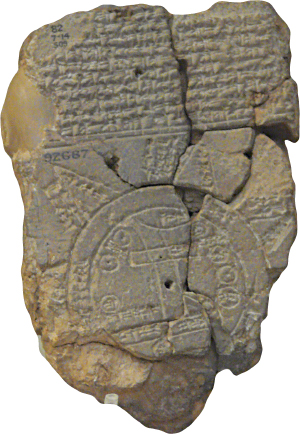Judgment Against the Nations (2:4–15)
Gaza … Ashkelon … Ashdod (2:4–7). The oracle against Philistia predicts the quick destruction of Gaza, Ashdod, Ashkelon, and Ekron. As stated, southern Philistine towns that may have been under Egyptian control, such as Gath, are not mentioned here. It is known that Sargon II of Assyria claimed to have taken Gath in 712/711 B.C., and there is no evidence of its rebuilding.34 Egypt had presumably taken this area over near the end of the reign of Ashurbanipal of Assyria sometime after 640 B.C., when the Assyrian empire was in serious decline. Thus, Egypt rushed into southern Palestine to fill a “power vacuum.”
Midday (2:4). This implies a conquest that would take one half day. This is ironic, as it took the Egyptian monarch Psammeticus I nearly thirty years to take Ashdod (c. 640–611 B.C.), a siege that was probably in progress while Zephaniah was prophesying.35 Thus, Yahweh will not make this conquest a long drawn-out matter but will take the area rapidly. Esarhaddon of Assyria (681–668 B.C.) claims to have taken Egyptian Memphis in “half a day.”36
Kerethite (2:5). The Kerethites were probably a subgroup of Philistines, coming from Crete (Caphtor), although this relationship is not entirely clear.37 They are often associated with the Pelethites, both of whom were used as mercenaries in David’s army (e.g., 1 Sam. 30:14; 2 Sam. 8:18). Apparently Philistia stayed loyal to Assyria during its weakness and attempted to block Egyptian incursions into Palestine.38 Herodotus notes that Psammetichus I (664–610 B.C.) campaigned in Philistia against Ashdod and Ashkelon.39
Remnant of the house of Judah (2:7). Josiah expanded Judean territory into Philistia as far as the Mediterranean Sea north of Joppa, based on an ostracon found at Yabneh Yam, which shows evidence of a Judean governor during the time of Josiah at the fortress of Mesad Hashavyahu between Ashdod and Joppa.40 Zephaniah may have been alluding to this expansion. Archaeological excavations at Ekron (Tel Miqne) give evidence of concern for exiles, as the Assyrians expanded the size of the site, constructed a new citadel tower, and rebuilt the mudbrick city wall.41 The Assyrians evidently moved large numbers of Israelites to Ekron to work on their olive oil industry.42
Moab … Ammonites (2:8). Little is known about the relationship of Judah to these Jordanian states in the latter half of the seventh century B.C. In fact, there are a few pieces of information that may shed light on this period. Both Moab and Ammon were among nations that gave tribute to Assyria during the reigns of Sargon, Sennacherib, and Esarhaddon.43 This verse implies that they had moved into Judean territory.
Our understanding of the region in this period is mainly linked to Qedar, a nomadic Arabic tribe known in Genesis 25:13 as descendants of a son of Ishmael. Assyrian sources describe Qedarite movements into the Transjordan after 640 B.C., causing warfare between the Qedarites and Assyria. Ashurbanipal (668–627 B.C.) claimed victories over Uateʾ of Sumu-il (presumably Ishmael) and Qedar.44 Moreover, Kamashalta of Moab defeated the Arab (i.e., Qedarite) forces of Ammuladin at roughly the same time.45 It is likely that the strife resulting from the movement of the Qedarites into this region, coupled with the Josianic expansion, may have weakened Ammon and Moab, which is reflected in the oracles.
It is interesting to note that Edom, the other Transjordanian state in the region with connections to Judah, is not mentioned here. As stated previously, it is probably because Edom was under Egyptian control (as they were in southern Philistia), and Egypt was not in direct conflict with Judah at this point, though that was to change after the fall of Nineveh in 612 B.C.
Nations on every shore (2:11). A Babylonian map of the world may shed light on this phrase, as it has Babylon and nearby Mesopotamian nations in the center of a landmass, surrounded by a large body of water. Beyond the water are small lands, or islands in the midst of the “sea.” Perhaps the Hebrew phrase betrays a similar usage of the conceptual “map,” in that Israel was in the center of the earth with other “coastland” nations surrounding it, along with a large body of water.46

Babylonian world map
Caryn Reeder, courtesy of the British Museum
Cushites (2:12). The historical context for this oracle is not certain, as the Ethiopian (or Cushite) dynasty of Egypt ended in 664 B.C. with the Assyrian conquest of Thebes.47 It appears to imply that the Assyrian victory was done under Yahweh’s providence. Psammetichus I, the founder of the Saite (or XXVIth dynasty), was not allied with Judah until 616 B.C. There is no evidence of Cushite (as opposed to Egyptian) troops that may have been sent to help Assyria.
Zephaniah may merely be noting the passing of the Cushite dynasty of Egypt, when Tirhakah died in 663 B.C., fleeing from the Assyrian conquest of Thebes. Interestingly, the present Egyptian dynasty is not mentioned at all.
Assyria (2:13). Assyria had been the main oppressor of Judah for a century, so an oracle against it is not the least bit surprising. The oracle sees the destruction of Nineveh and Assur (occurred in 614–612 B.C.) as in the future; thus the oracle must have been written prior to this. The destruction of Nineveh is portrayed in language similar to ancient Near Eastern treaty curses (see comment on 1:13).48 Xenophon, in his travels in Upper Mesopotamia, noted that by 401 B.C. Nineveh had become desert sand.49